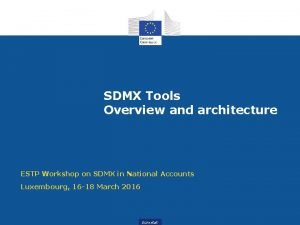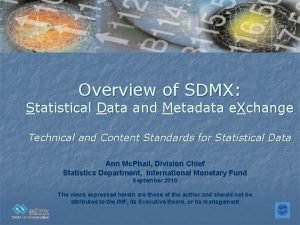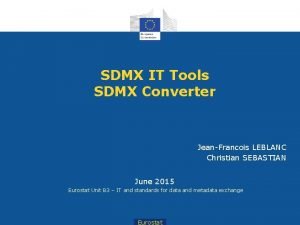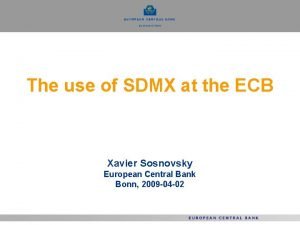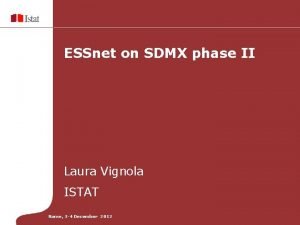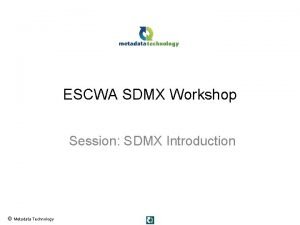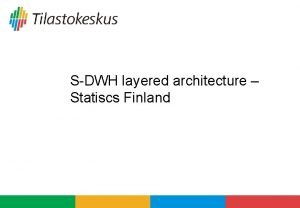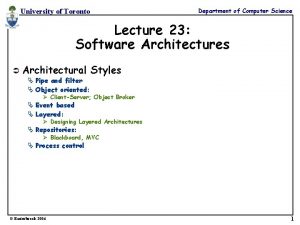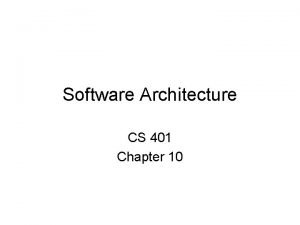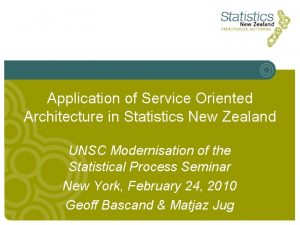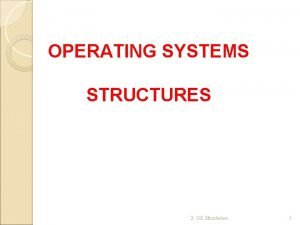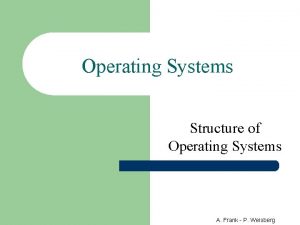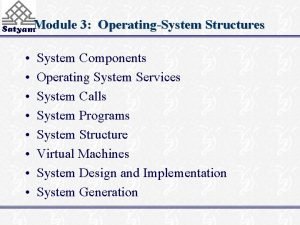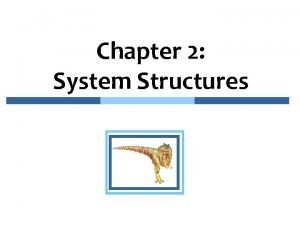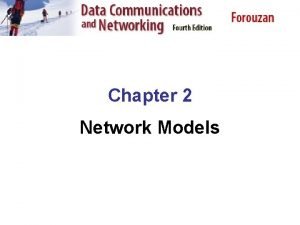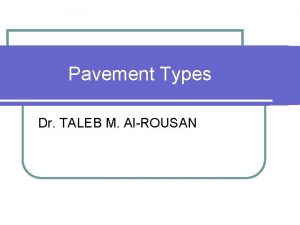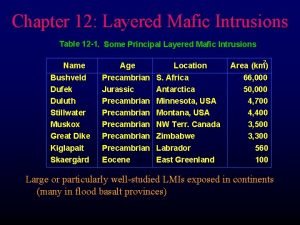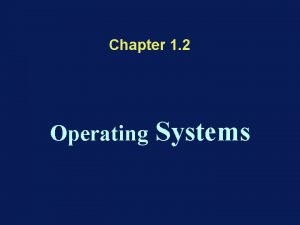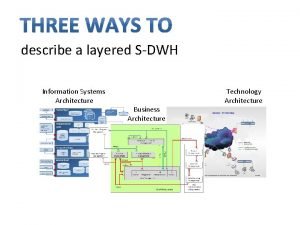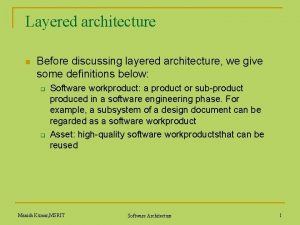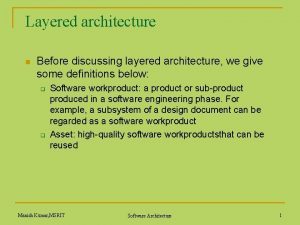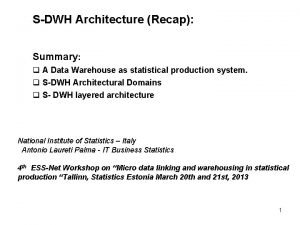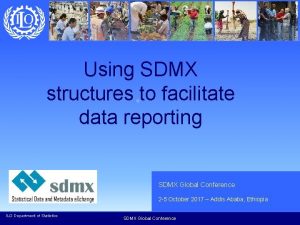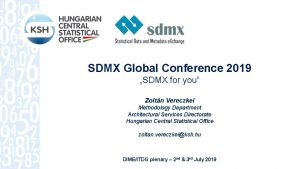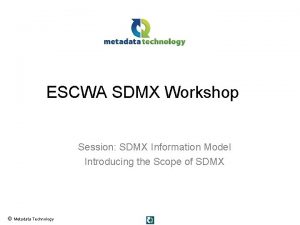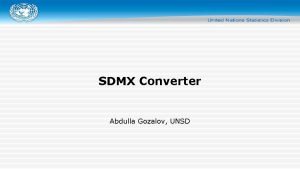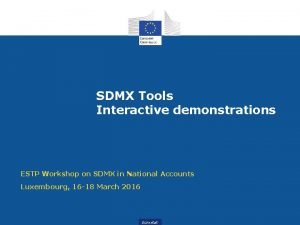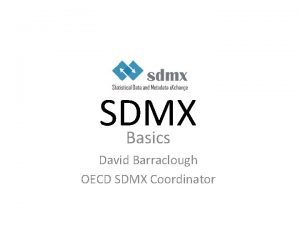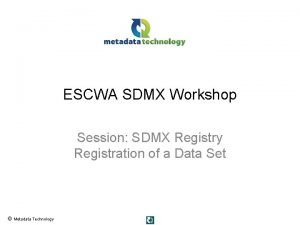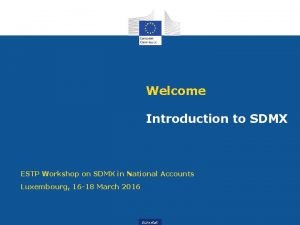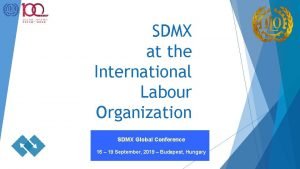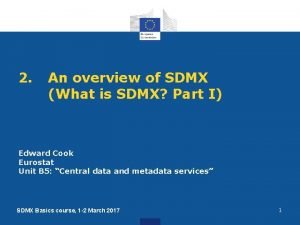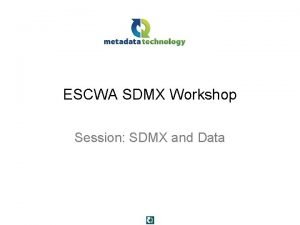SDMX in the SDWH Layered Architecture Statistics Portugal




























































- Slides: 60

SDMX in the S-DWH Layered Architecture Statistics Portugal Department of Methodology and Information System Information Infrastructure Service Sónia Quaresma Sep 2015 Workshop of the Co. E Dublin « «

Overview – Presenting SDMX – GSBPM Model – Data Warehouse Layers – Mapping SDMX uses on GSBPM Model within a Layered Architecture – SDMX tools in the Data Warehouse

Statistical Data and Metadata Exchange SDMX is an initiative from a number of international organizations, which started in 2001 and aims to set technical standards and statistical guidelines to facilitate the exchange of statistical data and metadata using modern information technology

Statistical Data and Metadata Exchange SDMX consists of: -Technical standards (Inform. Model), - Statistical guidelines, and - IT architecture and tools

Statistical Data and Metadata Exchange

Information Systems Architecture Source Layer Integration Layer Interpretation Layer Access Layer Staging Data Operational Data warehouse Data Marts ICT - Survey SBS - Survey DATA MINING ANALYSIS EDITING ET- Survey. . . Operational information ADMIN Metadata Data warehouse REPORTS ANALYSIS Data Mart

Information Systems Architecture Source Layer Integration Layer Interpretation Layer Access Layer Staging Data ICT - Survey SBS - Survey ET- Survey. . . ADMIN Usually of temporary nature, and its contents can be erased, or archived, after the DW has been loaded successfully

Information Systems Architecture Source Layer Integration Layer Operational Data EDITING Operational information Interpretation Layer Access Layer designed to integrate data from multiple sources for additional operations on the data. The data is then passed back to operational systems for further operations and to the data warehouse for reporting

Information Systems Architecture Source Layer Integration Layer The Data Warehouse is the central repository of data which is created by integrating data from one or more disparate sources and store current and historical data as well Interpretation Layer Data warehouse DATA MINING ANALYSIS Data warehouse Access Layer

Information Systems Architecture Source Layer Integration Layer Interpretation Layer Access Layer Data Marts Data marts are used to get data out to the users. Data marts are derived from the primary information of a data warehouse, and are usually oriented to specific business lines. REPORTS ANALYSIS Data Mart

GSBPM Model • The Generic Statistical Business Process Model defines and describes statistical processes. • It is a matrix and a strict order between it’s sub processes does not exist.

GSBPM Model

STATISTICAL WAREHOUSE Layered architecture DATA WAREHOUSE Access Layer Interpretation Layer OPERATIONAL DATA Integration Layer Source Layer data are accessible for data analysis Used for acquiring, storing, editing and validating data

Source Layer

SDMX and Collection Phase (Step 4) SDMX is more appropriate for Macro Data and as such does not relate directly to the source layer where Micro Data is primarily concerned.

SDMX and Collection Phase (Step 4) There are some exercises in which SDMX is being used with Micro. Data – data exchange exercise on Business Registers.

SDMX and Collection Phase (Step 4) ISTAT metadata experts are modelling some microdata sets with SDMX

SDMX in the Source Layer The structure of a dataset in SDMX is described using a Data Structure Definition (DSD), in which the metadata elements are: 1. dimensions, which form the identifiers for the statistical data 2. attributes, which provide additional descriptive information about the data.

SDMX in the Source Layer When several actors are involved it is easier to achieve coherence and guarantee integrity if all abide to the same DSD.

SDMX Potentialities SDMX as a Model for the Structures of the Metadata Repository or/and the Statistical Data. Warehouse

Integration Layer

SDMX and Process Phase (Step 5) Aggregates can be captured in a standard SDMX format

5. 7 Calculate Aggregates No direct use of SDMX but derived variables and recodes must match the requirements of the standard DSD to ensure comparison

5. 8 Finalise Data FIles Use of SDMX-ML DSD and data formats to format aggregates. There are several “flavours” of SDMX to create SDMX-ML data sets.

5. 8 Finalise Data Files “Flavours” of SDMX: -SDMX-EDI (also known as GESMES/TS) -SDMX-ML (the XML version)

5. 8 Finalise Data Files The SDMX Technical Working Group is extending the formats of SDMX: -JSON – there’s already a published proposal - CSV – could be a very important format for microdata exercises

SDMX Potentialities SDMX usage for EXTRACTION, TRANSFORMATION and LOAD of DATA

Interpretation Layer

SDMX and Analyze Phase (Step 6) SDMX can provide some useful functions for the Analysis of Aggregates

6. 1 Prepare Draft Outputs SDMX can help to visualize and process data, and can be used as a source format for outputs

6. 1 Prepare Draft Outputs Relies on technologies which easily transform XML into other output formats

6. 2 Validate Outputs SDMX-ML provides validation of all rules in the DSD (correct codes, complete and valid descriptions and keys, etc. )

6. 2 Validate Outputs Some validation can be performed by XML schema (e. g. use of valid codes and dimension Ids)

6. 3 Interpret and Explain Outputs SDMX visualizations may help to easily view data

6. 3 Interpret and Explain Outputs SDMX visualizations may help to easily view data and generate views for output products

6. 4 Apply Disclosure Control It is not a primary application for SDMX but visualizations can help to verify disclosure processing.

6. 5 Finalize Outputs SDMX visualizations may provide views of data for final outputs, which may be generated on-demand for dissemination on Website for example.

SDMX Potentialities Reporting with SDMX: -Push reporting format for data and metadata -Pull reporting format for data and metadata

Access Layer

SDMX and Disseminate Phase (Step 7) SDMX most immediate usage in S-DWH is in the access layer which is intended for the final presentation, dissemination and delivery of information to end users.

7. 1 Update Output Systems SDMX provides useful format for loading into output systems.

7. 1 Update Output Systems SDMX can be used as a format for the exchange of data between systems, whether these systems are internal to an organization, or external.

7. 1 Update Output Systems Most tools and databases provide good support for XML formats such as SDMX-ML, so SDMX-ML can be used as input to systems for creating HTML, PDF, Excel, and other output formats.

7. 1 Update Output Systems SDMX Registry can make the reporting of data more automated by using the data registration mechanism supported by a registry. Once new data has been registered, the data user can simply query the service for the new data. This helps to ease the burden of data reporting.

7. 2 Produce Dissemination Products SDMX visualizations may provide views of data for final outputs. Outputs may be generated dissemination on Websites, etc. on-demand for

7. 3 Manage Release of Dissemination Products SDMX serves as a format for reporting and dissemination to some users/data collectors. SDMX serves also as basis for generating other outputs; static or on-demand.

7. 4 Promote Dissemination Products The use of SDMX Registry Services provides a high level of visibility for data.

7. 4 Promote Dissemination Products The use of SDMX Registry Services provides a high level of visibility for data. It depends on the availability of a domain registry for this purpose – requires the new data to be registered.

SDMX Potentialities Discovery and Visualization: -To drive website presentation of data and metadata - As a queryable data source - For standardized file downloads

SDMX tools for the Source Layer Some SDMX tools for the Registry/Metadata Repository: • Eurostat SDMX-RI • Eurostat SDMX Registry • Metadata Technology Fusion Registry • ISTAT SDMX-RI Mapping Store Extension • ISTAT SDMX-RI Web Service Extension

SDMX tools for the Integration Layer Some relevant SDMX tools for modelling and building the Structures of the S-DWH: • Eurostat DSW • Metadata Technology Fusion Matrix • Metadata Technology Fusion Transformer, Cloud • ISTAT Loader Builder Weaver,

SDMX tools for the Interpretation Layer Some relevant SDMX tools for reporting: • Eurostat SDMX-RI • Eurostat SDMX Converter • ECB SDMX Java suite • Panda. SDMX

SDMX tools for the Access Layer Some SDMX tools for discovery and visualization as well as Machine-Actionable Dissemination: • Eurostat SDMX-RI • Metadata Technologies Fusion Matrix • ISTAT Web Browser • ISTAT SDMX-RI Web Service Extension • Flex CB Visualization

SDMX tools

SDMX tools

SDMX tools

SDMX tools

SDMX tools Layers / Tools Access Layer Eurostat SDMX-RI ISTAT Eurostat MT Fusion Weaver, MT Fusion Loader DSW Matrix Registry Transformer, Cloud XL Builder ISTAT SDMX-RI ISTAT Flex CB Panda Web Mapping Store Web Service Excel Plug Visualizati SDMX Browser extension extention -in on Machine-Actionable Dissemination X Discovery and Visualization X Client stand-alone X X Interpretation Layer Reporting X Modelling SDWH Building SDWH Integration Layer Source Layer Eurostat SDMX Converter Registry/Metadata repository X X X X X X X

Thank you for your attention

Questions ?
 Sdmx excel
Sdmx excel Http://sdmx.us:8080
Http://sdmx.us:8080 Sdmx converter
Sdmx converter Website localization statistics
Website localization statistics Sdmx istat
Sdmx istat Sdmx converter
Sdmx converter Layered statistics
Layered statistics Vdss cloud
Vdss cloud Gartner pace layer
Gartner pace layer Layered architecture for web services and grids
Layered architecture for web services and grids Layered task in network model
Layered task in network model Introduction to jini
Introduction to jini Layered architecture
Layered architecture Layered architecture
Layered architecture Introduction to statistics what is statistics
Introduction to statistics what is statistics Application of statistics in architecture
Application of statistics in architecture Metamorphic rocks with a layered or banded look are called
Metamorphic rocks with a layered or banded look are called Fillings and spreads for sandwiches
Fillings and spreads for sandwiches Process abstraction in os
Process abstraction in os Operating system
Operating system Layered kernel
Layered kernel Layered structure in os
Layered structure in os Layered structure in os
Layered structure in os Dewy pleura
Dewy pleura Layered kernel
Layered kernel Inflation in ansys
Inflation in ansys Layered structure in os
Layered structure in os Layered tasks
Layered tasks Layered tasks
Layered tasks Name and explain the four basic haircuts
Name and explain the four basic haircuts A robust layered control system for a mobile robot
A robust layered control system for a mobile robot Software engineering a layered technology
Software engineering a layered technology Layered technology in software engineering
Layered technology in software engineering Jpcp pavement
Jpcp pavement Layered curriculum
Layered curriculum Layered curriculum template
Layered curriculum template Layered curriculum
Layered curriculum Causal layered analysis
Causal layered analysis Parts of a razor milady
Parts of a razor milady Layered mafic intrusion
Layered mafic intrusion Layered operating system
Layered operating system A robust layered control system for a mobile robot
A robust layered control system for a mobile robot Reasons for using layered protocols
Reasons for using layered protocols Layered pattern
Layered pattern Hình ảnh bộ gõ cơ thể búng tay
Hình ảnh bộ gõ cơ thể búng tay Slidetodoc
Slidetodoc Bổ thể
Bổ thể Tỉ lệ cơ thể trẻ em
Tỉ lệ cơ thể trẻ em Voi kéo gỗ như thế nào
Voi kéo gỗ như thế nào Tư thế worm breton
Tư thế worm breton Bài hát chúa yêu trần thế alleluia
Bài hát chúa yêu trần thế alleluia Môn thể thao bắt đầu bằng từ chạy
Môn thể thao bắt đầu bằng từ chạy Thế nào là hệ số cao nhất
Thế nào là hệ số cao nhất Các châu lục và đại dương trên thế giới
Các châu lục và đại dương trên thế giới Công của trọng lực
Công của trọng lực Trời xanh đây là của chúng ta thể thơ
Trời xanh đây là của chúng ta thể thơ Cách giải mật thư tọa độ
Cách giải mật thư tọa độ 101012 bằng
101012 bằng độ dài liên kết
độ dài liên kết Các châu lục và đại dương trên thế giới
Các châu lục và đại dương trên thế giới Thể thơ truyền thống
Thể thơ truyền thống
